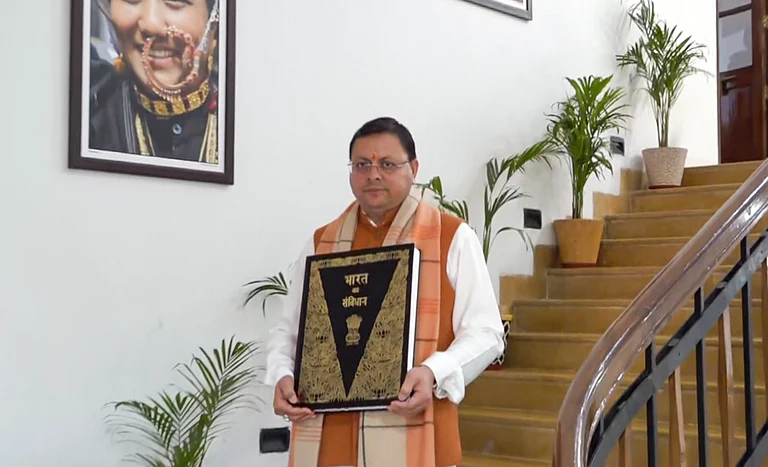It has been 50 years since Gaura Devi of Reni village in Chamoli district in Uttarakhand and her fearless companions stared down the barrel of a gun, refusing to allow the contractor’s men and employees of forest dept to butcher the forest they called home. Gaura, along with 20 women and seven girls present with her on March the 26th, 1974 told the drunk forest guard that she would face bullets before any harm be done to the ecosystem that was crucial to their sustenance.
Gaura, with the Rishi Ganga River flowing below her and the mighty Nanda Devi looming large beyond that, told the men not to cut their forest saying that it was their maika (maternal home). They claimed that cutting of the trees would cause their village to flood, as the forest served as a natural blockade for surrounding rivers. The act of ‘hugging trees’ was becoming common in nearby villages, yet it was this moment of defiance that catapulted the ‘Chipko’ movement to a national and eventually, international stage.
Renowned social activist and environmentalist Chandi Prasad Bhatt along with others made his way to Reni upon hearing the news. The ensuing national attention made profiteering from the destruction of the forest virtually impossible for years to come. Chipko is a testament to the power of non-violent and community-centric endeavors, and goes to show that more often than not, taking a stand against what is wrong is more than half the battle.
Today, it remains the most prominent forest conservation movement to have emerged from our state of Uttarakhand and its prevalence continues to ring loud and clear. Although Reni’s name is one that can never be forgotten because of the resounding impact that the Chipko movement had, what most people don’t know is that Reni today is almost inhabitable. This is because of multiple floods the area has faced over the past few years, with geologists suggesting that the residents should relocate.
What makes this predicament unfortunate is that the damage done to Reni and countless other towns and villages in Uttarakhand has occurred due to man-made natural disasters. Deforestation and the construction of massive roads and hydro projects have left the mountains gasping for air. Will we need to wait for the next Gaura Devi before we realize that the same things that applied in 1974 apply today as well? We must protect our Jal, Jungle and Zameen (forests, land and water) and learn to live in harmony within the ecosystem we are so fortunate to be a part of.
As we commemorate the indomitable spirit of Gaura Devi and her comrades on the 50th anniversary of Chipko, we must also acknowledge the urgent need for collective action in preserving our natural heritage. The Chipko movement's legacy serves as a beacon of hope, inspiring us to stand up against environmental degradation and advocate for sustainable practices. It reminds us of those ordinary individuals, when united in purpose, can effect profound change for the betterment of all.
It is equally imperative that we heed the warnings echoed by the ecological crisis plaguing Reni and similar regions. Climate change exacerbates these challenges, underscoring the urgency of our actions. We must prioritise conservation efforts and adopt eco-friendly policies to mitigate further harm to our ecosystems.
Seen from a larger, macro lens, it’s crucial to recognise that climate change, infrastructure projects, the young mountain ranges, flouting of carrying capacity principles and finally human greed are causing the most damage in Uttarakhand, increasing risks and vulnerabilities substantially.
If the central and state governments, industry, businesses and people are seeking a brighter future for Uttarakhand, then there is a need to step back and curtail the current model of development. This is not working and the writing is clear on the wall. As a state, Uttarakhand needs to change its trajectory, conserve resources and cut down on risks.
Specifically, the Himalayas and Uttarakhand can only be saved if governments act differently. Giant infrastructure projects like road widening of Char Dham, hydro power projects, increasing urbanisation, rampant mining, irresponsible muck disposal and over tourism amongst others have caused maximum damage to the Himalayas. Focusing attention to only man-made climate change or saying people should be made aware about the Himalayas is a clever attempt at shifting the goal post and attention from real issues.
Coming back to Chopko and the legacy of Gaura Devi, let’s take some inspiration from the valiant efforts of the women of Reni while accepting that holding onto nostalgic victories alone will not solve the massive challenges we face today. With the climate crisis exacerbating matters, it’s in many ways a herculean challenge to humanity and all else that falls within our fragile ecosystem. Yet, let us celebrate the fearless courage of the women of Reni and try invoking a bit of Gaura in our own selves. Perhaps that would be the most apt remembrance on the 50th anniversary of the Chipko movement of Uttarakhand!
(Anoop Nautiyal is a Dehradun based social worker)
























